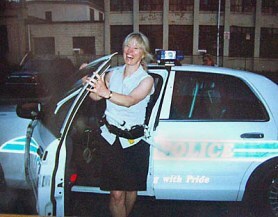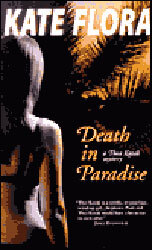The Back and Forth of Storytelling
Kate Flora: Starting a new book in a long-running series is like getting together with old friends not seen for a while. That’s where I am right now. I’m only about four chapters into the next Thea Kozak mystery, Until Death Do Us Part, but it already feels like home. It also feels like a lesson in mystery writing in practically every sentence.

A much younger me
Although I do some planning before I start, much of the process of writing is like reading a good book, one I can’t wait to return to so I can see what happens next. But while I have an idea of where I’m going, thirty years in the writer’s chair means that I have an array of editor’s heads perched on my shoulders, whispering advice in my ears.
I open with Thea watching her small son Mason toddling across the floor. But of course there will always be new readers who don’t know Thea or haven’t followed her through the previous eleven books and don’t know who Thea is or the story of Mason’s birth. So the progress of this book is: write a few sentences. Pause. Go back and edit those sentence to make clear to the reader who the characters are and a small bit of backstory.

Learning about cops in a citizen’s police academy
I write a few more sentences. The nanny is sick. Thea is trying to finish a report for a difficult client because Suzanne is sick with the flu. Oh. Must stop again and explain a bit about what Thea does. Who Suzanne is. And then, only a few more sentences on, when there is a knock on the door, Dom and Rosie Florio are on the doorstep, and I need to put in a teeny explanation about how Thea knows them.
Whew! Now maybe I can get down to the writing the story. The phone has been ringing, and when Thea checks her messages, things get instantly complicated. There has been a homicide at a client school, and Thea, as her firm’s crisis specialist for private schools, needs to get to the campus as soon as possible to help them deal with a terrible situation. But: no nanny. Her husband the homicide detective is working a case. And a client is waiting for a report. Have I created enough tension yet?

Mass Market Paperback
Then there are those on-going questions: have I created a situation that will draw readers into the story? Have I developed the characters enough to give readers a reason to want to spend time with them? And I including enough detail to give a sense of place, a sense of why any of this matters, a sense of time passing and pressure increasing? And I mustn’t forget the new source of tension for Thea, who has always been free to head off and troubleshoot her client’s problems: who will care for her toddler son, and how will she handle her first overnight separation while also dealing with distraught staff at the client school and all the details of managing a fraught situation?
Sometimes it all flows organically from the initial idea. More often, the process is like the one for this book. I start with a campus crisis where a headmaster has been killed and see what evolves. I write something. Ponder on it. Go back and add some more detail. Saying that the headmaster has been shot isn’t very detailed. Saying that after there is a gunshot, his wife comes out of his office holding a gun and says “he’s dead,” gives more detail to pull us into the story and raises more questions. Did she shoot him? Saying that she then set down the gun and now has disappeared adds yet another question to the story. Why did she run and where has she gone?

yes, it often feels like being perched on a rock in midstream but we always make it across.
But still I have the question: have I done enough to make the murder feel mysterious and urgent? Have I given the kind of detail that will show the acting headmaster’s shock? I go back and describe his voice on the phone, in the voice message he’s left. Then, when Thea speaks with him, he provides another graphic detail: the dead headmaster has been shot in the face. There’s blood everywhere and it’s horrible. This allows the reader more information but also allows Thea to understand how traumatized he is and compare it to her own unfortunate experience with other dead bodies.
I’m only four chapters in, and already I’ve done a lot of rewriting. Those editing heads that sit on my shoulders have been very busy, and I expect they’re going to be sitting there for the whole book. Maybe they’ve missed Thea and Andre too? As for constantly having to go back and edit myself? I’m loving it. I’m enjoying watching greater details emerge, and small things happen that may become important later. I’m enjoying watching the dynamics among the characters. Who will be easy to work with; who will be difficult. Who is open and helpful; who appears to be hiding something. And always I’m keeping an eye on that central question: Why was someone killed and what are the ripples through the community.
Welcome to Crime Fiction 101: storytelling, details, pacing, tension, character development. Have I set the hook and raised enough questions in my readers’ minds to keep them turning the pages. Then, as the book develops, another overarching question will emerge: What is this story about and what do I want my readers to take away.
Lea Wait's Blog
- Lea Wait's profile
- 508 followers



